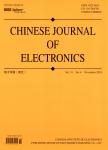RFID-Based WSN Communication System with ESPAR Array Antenna for SIR Improvement
RFID-Based WSN Communication System with ESPAR Array Antenna for SIR Improvement作者机构:Department of Electronic EngineeringChungbuk National University
出 版 物:《Chinese Journal of Electronics》 (电子学报(英文))
年 卷 期:2023年
核心收录:
学科分类:080904[工学-电磁场与微波技术] 13[艺术学] 0809[工学-电子科学与技术(可授工学、理学学位)] 08[工学] 1305[艺术学-设计学(可授艺术学、工学学位)] 0810[工学-信息与通信工程] 080202[工学-机械电子工程] 081104[工学-模式识别与智能系统] 080402[工学-测试计量技术及仪器] 0804[工学-仪器科学与技术] 081001[工学-通信与信息系统] 0802[工学-机械工程] 081101[工学-控制理论与控制工程] 0811[工学-控制科学与工程]
摘 要:To improve the received signal strength(RSS) and signal-to-interference and noise ratio(SINR),electronically steerable parasitic array radiator(ESPAR)array antennas are designed for the ultra-high frequency(UHF) radio frequency identification(RFID) communication systems that can provide very low power consumption in sensor tag edge. Higher gain, appropriate radiation pattern, and most power-efficient array antennas are completely essential in these sensor network *** a result, it is suggested that ESPAR array antennas be used on the RFID reader side to reduce interference, multipath fading, and extend communication range. Additionally, a system architecture for UHF-RFID wireless sensor network(WSN) communication is put forth in order to prevent interference from antenna nulling technology, in which ESPAR array antennas could be capable of generating nulls. The array antennas within the system demonstrate high efficiency, appropriate radiation patterns, and gains(9.63 dBi, 10.2 dBi, and 12 dBi) from one array to other arrays. The nulling technique using the proposed array antennas also provides better SINR values(31.63 dB, 33.2 dB, and 36 dB). Finally, the nulling space matrix is studied in relation to the channel modeling. Therefore, the suggested approach might offer better communications in sensor networking systems.



